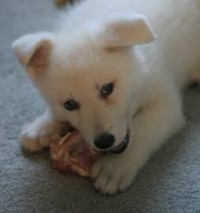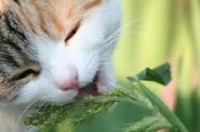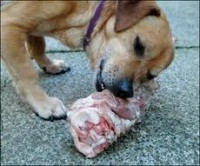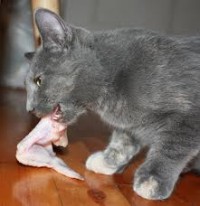Evolutionary diets
Since every consultation I undertake with new clients revolves largely around diet and nutrition I considered it was high time I posted my recommendations here.
The basis for good health is good nutrition and whilst there are exceptions, the basis of feeding cats and dogs is raw meaty bones. Despite the jargon and hype and persuasion of pet food manufacturers and those with commercial interests, common sense will prevail.

Here is the simple plan for those less interested in reading on for the philosophy.
Raw Meaty Bones
Raw meaty bones comprise 90% of the diet. This involves fresh meat on the bone with fat. Soft boned meats are recommended like turkey necks, chicken wings and necks and frames, rabbits, duck quail etc depending on availability and budget. For larger dogs we can also use lamb necks, beef brisket for large breed, lamb flaps (ribs with meat and fat), roo tails. AVOID MARROW BONES or legs of lamb, lamb shanks as these can cause tooth breakage even in large dogs. Feeding the knuckle ends of these bones is recommended but not the shafts.
In this way the balance of Ca:P is accurate with no need to measure or supplement. Puppies and older dogs can have ground up whole chicken frames raw. Puppies need extra food for growth but may not be able to chew enough for their requirements so will need bone and meat mince.
All of these foods can be frozen until required if that is necessary.
Greens
Added to this they will occasionally need some raw fresh vitamised greens or they will chew grass, which is perfectly natural and good. For those starting out on raw feeding and requiring a bit of detoxifying from old grain based regimens, the addition of chlorella is beneficial. Any greens we eat can go into a blender raw and be tipped over their meat ration. Care with brassicas and broccoli but a little is very good. Use celery, parsley, spinach, silverbeet, beetroot and leaves, other green edible salad leaves, carrot etc
NO ONION, some garlic is good for flea control as is mint.
This will not look pretty but a slurry like this tipped over the meaty bones a couple of times a week will boost essential nutrients. Chlorophyll is a blood glucose regulator. Amount of green slurry is variable but a couple of tablespoons a few times a week is sufficient. More is fine, as some love it. This, in some way, mimics the gut contents of the prey they eat naturally. The addition of some natural yoghurt and the occasional raw egg is also OK. Some people make up more than they need and it can be frozen in ice cube trays for convenience.

Oils
Essential fatty acids are found in animal and plant sources.
Dogs and cats will benefit from the addition of some plant oils like flax oil especially if they are prone to skin or nervous problems. Flax brings calmative properties.
Dose guide teaspoon daily for small dog and cats and tablespoon for large dogs.
I use fish oils by preference for dogs with brain and nervous system dysfunction as the DHA and vitamins E and D are good brain nutrients. Cod liver oil is very good and ethical oil production is sought.
Dogs and cats supply their own VitC but I recommend extra for those under stress or recovering from illness or injury. Calcium ascorbate is recognised as the form of choice and I use high potency supplementation as required.
Twenty or more years ago, an Australian veterinarian went out on a limb and effectively ‘crucified’ himself professionally by his outspoken persistence in promoting raw meaty bone diets for dogs. His contention was that the prevalence of dental disease and bad health in dogs stems from feeding them soft and cooked unnatural diets. He was right. There is now a large body of people from all walks of life who believe him and understand his passion. Furthermore the ramifications of the true health picture from feeding commercially prepared foods are still unfolding.
Dental disease is the most obvious fallout of bad diet but so is kidney, liver, and heart disease, not to mention allergy, skin disease, gut problems and flatulence.
In Australia we are far more fortunate with our prepared pet foods than the USA for example. Our food regulations here prevent the use of condemned products like euthanised animals, dead pets and road kill from being rendered into pet food but there are horror stories emerging from overseas.
I have no doubt about the integrity of our pet food manufacturers, my objection is the premise that commercially prepared food constitutes best diet and is promoted by professionals and all and sundry as the recommended practice.
When we were kids, dog poo was white. This is normal when dogs are fed raw meaty bones.
So where did our senses desert us? I think that once we started embracing the ‘one stop supermarket stop’ in the mid seventies we began neglecting not only our own health but that of our furry companions. There is a whole generation of people now who believe that pet food comes in packets and cans and the more you pay the better the quality. The truth is the best quality pet foods are the cheapest off cuts at butchers.
Needless to say, there are still many controversies surrounding good diets for dogs and cats and these will continue as long as big money is at stake.
As undergraduate Veterinarians we were treated to a trip to a very large pet food manufacturers as the basis of our pet nutrition lecture series. Our textbooks on small animal nutrition were also provided by pet food manufacturers and words cannot describe how I feel about the fact that now, twenty five years later there is a Chair of Small Animal Medicine at my university funded by a large American multinational pet food company.
Dogs and cats have evolved alongside with us for thousands of years but the fact remains that they are still physiologically carnivorous. Nobody will deny that a cat fed a vegetarian diet will die. Whilst some dogs can certainly adapt to vegetarianism owing to their omnivorous capacities, the majority of them will do better with raw meaty bone diets.
All commercially prepared complete pet foods are grain based.
Grains cause increased tendency to inflammation hence the cleverly formulated potato and fish diets for skin disease. Maybe it is better to try to avoid grains in the first place. Whilst dogs grazing in the wild will scavenge anything from the forest or paddock floor including grains, faeces, grass and small prey dead or alive, the most robust and fittest will hunt and kill quarry like rabbits, birds, small rodents and eat them whole. There are very few dogs alive that I can imagine routinely bringing down an ox, so feeding beef is probably unnatural for them.
In reality we will find it difficult, if not unpleasant, to try to replicate a completely natural diet for our carnivorous pets because we have no access to supplies of fresh small rodents, many birds and other prey and we don’t want to encourage the killing of our urban wildlife. In New York City, I was very surprised that even the availability of fresh raw chicken wings for pets is virtually impossible, such is our reliance on commercially prepared foods both for ourselves and our pets.
We also need to be mindful of the hormone effects of feeding chickens and other animals grown with growth promotants. Even though this practice has largely been regulated and outlawed in Australia, there are still cases of inexplicable weight gain and mammary development in dogs fed on raw chicken. Sourcing from organic suppliers or more ethical producers will avoid this issue.
Anybody with an animal having been diagnosed with pancreatitis will know the phobia associated with fat in the diet. I wonder how many cases of pancreatitis there were before the seventies. Raw fat is the basis of energy production in dogs and cats. Raw fat contained in raw meaty bones diet is an essential nutrient. Commercial foods all contain cooked fats. In fact, the unpalatable dry foods are coated with a layer of cooked fat to enhance their appeal. Raw fat is always safe to feed these animals unless they are already seriously compromised.

There will be challenges to raw food feeders over parasites. Why do we deworm animals every three months when they are fed commercial diets?
Raw foods passed for human consumption are deemed free from contamination and common sense prevails regarding worm prevention programs.
We need to be mindful of hydatid disease in Australia and monitor rabbits and offal for hydatid cysts.
After feeding raw meaty bone diets for ten years, I am content that the risk of parasite problems is no greater than with any other program. On the contrary, dogs and cats fed natural diets have stronger immunity and more robust constitutions.
It is, admittedly, a largely unnatural environment we provide for our pets these days as they have become child substitutes in some cases, knocking back puppacinos on the Saturday morning coffee rounds. Nevertheless, they are still animals and having deprived them of most of their natural loves, rolling in smelly things, hunting, roaming and mating, we owe them what we can.
Chewing is the last natural dog and cat behaviour we can ill afford to deprive them.

If you enjoyed reading this, see chewing things over and the paper on Evolutionary Nutrition for the Dog by Sarah Godfrey and don’t forget to get Dr Clare Middle’s excellent book

December 17th, 2012 at 1:35 am
I have found that switching my dog to a natural food diet very easy as she will eat whatever I give her. However changing the cats diet has proved to be very difficult. They are very fussy and will only eat Safeway tuna. They are so fussy with this that I can’t even give them Coles tuna. When I’m cooking they will come for tiny pieces of beef or lamb but they will eat only a couple of pieces.
I was wondering if I minced up the new natural food and add it to their regular food a tiny bit at a time and gradually increase the amount until they get used to the new diet. Do you think this method might work?
October 14th, 2012 at 9:12 am
G’day Dr. Pearson
I have been searching for information on a natural diet for my dog and two cats for a long time. It seems that I have finally found it.
June 1st, 2012 at 12:48 pm
Grateful to you for creating this site. I AM in NYC and yes, just providing chicken wings is a challenge. The holistic pet stores, raw food companies that have popped up and even the farmer’s markets ( if you care about hormone free chickens) have caught on and as a result, NO PART of any animal comes cheap any more. THere are no “off cuts” so long as someone has picked up that there is a regular MARKET for them. If someone hinted around asking for a bull penis, everyone would sell them for no less than $20 a pop! I use raw suppliers that ship plus one person in Huntington. Despite the expense, I would not pay for “premium” commercial pet food anymore, as it seems more like money thrown in the garbage to me. REAL FOOD for real animals. That is normal. That is healthy. That is nature.
January 5th, 2012 at 7:08 am
It’s good to see someone else who thinks like I do. With so much ignorance in the world these days it’s nice to know there’s someone out there who isn’t an idiot.
November 8th, 2011 at 4:59 am
Thanks for this page on a raw diet for pets. I have 2 large dogs and have been feeding raw bones, meat and vegetable combinations with the addition of brewers yeast and kelp etc etc. I agree wholeheartedly with the need for a preventative healthy diet for our pets. I will refer anyone who is interested to this informative web site.
March 22nd, 2011 at 2:43 am
Greetings Dr Pearson
I contacted you by phone last week regarding my concerns for my cat, Nellie. I thought that she may have digestive problems and you recommended putting her on a mainly raw diet. I have been feeding her chicken necks, chicken wings, fish , minced steak and have noticed a difference in her already. She has bouts of energy racing around the yard and up and down trees !
So Far so Good!
Thank you
Sue O’Donnell